 |
|
Here and There introduces art, artists, galleries and museums around Japan that non-Japanese readers and first-time visitors may find of particular interest. The writer claims no art expertise, just a subjective viewpoint acquired over many years' residence in Japan.
|
|
 |
|
|
 |
 |
A Cosmos in the Trivial: Hiroko Tsuchida at the Hiratsuka Museum of Art
Alan Gleason |
 |
Installation view of Hiroko Tsuchida: Where's a will, there's a way. From left to right, the four large works are jogi, delight, Catch a mountain, and push beyond one's limit. |
Hiroko Tsuchida describes her work as conceptual art, but that is not how it first struck me. Her choice of materials and her methods of making art from them are so impactful that one need not know what they represent, or what message they are meant to convey, to appreciate them on a visceral level. So I was surprised to find, after viewing Where's a will, there's a way, her current exhibition at the Hiratsuka Museum of Art, that she had written detailed, often very poetic, descriptions of what each work was about.
If there is a shortcoming to the show, it is that those texts are not to be found next to the works themselves, but in a booklet on an easily overlooked table near the entrance. They can also be read on the artist's website, some but not all with English translations. Her essays make it clear that Tsuchida begins a work with a certain theme or message in mind, then sets about figuring out how to express it -- in that sense, she is indeed a conceptual artist. In her words: "Material, shape, dimension, structure, all these express my philosophy. Completely conceptual art. [Something] that I want to express goes around in my head. It naturally comes up as a solid figure after I prepare that expression."
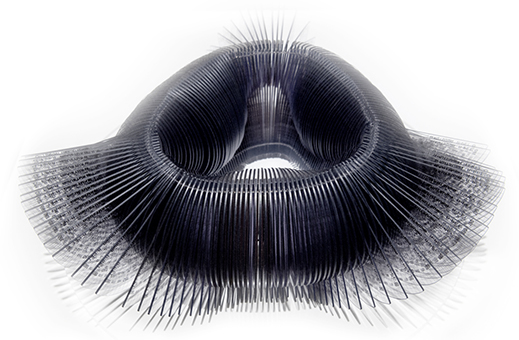 |
|
starline, 2017, protractors |
Much of what passes for conceptual art seems to get no further than the concept stage, with execution almost an afterthought. But Tsuchida's works, without exception, require serious time and effort to construct -- no "look up at the ceiling and imagine a cloud in the sky" fluff for her. Her M.O. more closely resembles the painstaking and repetitious toil of traditional artisans who follow a daily regime that most of us lesser mortals would find deadly tedious. Perhaps for the artisans, and artists like Tsuchida, it's a kind of meditation -- or is it really just a chore they accept as unavoidable to achieve their ends? Interestingly, it turns out that Tsuchida herself is a craftsperson by training, a maker of prize-winning jewelry before she began producing larger, more indisputably arty objects around six years ago. (She continues to make jewelry; examples of both her art and craft works can be seen on her website.)
|
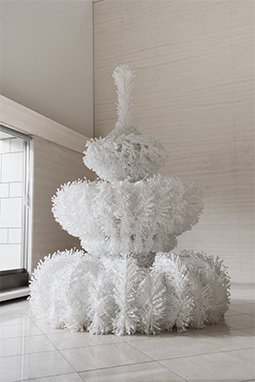 |
|
|
|
delight, 2018, plastic toothbrushes
|
Tsuchida's materials are small everyday objects that would normally strike us as utterly banal: swizzle sticks, safety pins, candy wrappers, thermometers, shoes. What she does with them, however, is magical. Following her muse she designs, then assembles, elaborate structures composed of hundreds or thousands of a given object. Among the larger works on display in Hiratsuka are a Mt. Fuji-like volcano of safety pins; a monumental chandelier-like object of white plastic throwaway toothbrushes; an abstract toroidal sculpture made of shiny black patent-leather high-heeled women's shoes; an embryonic, tumorous mass of twisted candy wrappers; a black swan made of plastic swizzle sticks; and a skull made of nails and screws.
Complementing these large standalone works are several smaller pieces displayed in rows in a couple of showcases. While these, too, consist of multiple identical household items -- kitchen graters, nail files, protractors, combs -- they are more abstract in execution yet, to judge by the titles, generally a bit more literal in conception. The prevailing theme is the relationship of women with the accessories that too often define or constrain them.
 |
|
Kejime~Woman's Routine, 2016, white plastic combs, wire |
Kejime~Woman's Routine (kejime roughly means "setting to rights"), for example, is a beautifully rendered sculpture made entirely of white plastic combs that snake around like some curly sea creature. In her essay about it Tsuchida describes the formation as representing the twists and turns of the autonomic nervous system. The comb, she explains, serves to periodically realign the hair that is so central to a woman's identity, but which is blown into disarray in the course of each day. To her, she says, combing her hair is like a realignment or resetting of the heart. Another assemblage, a truly jewel-like circular array of common kitchen graters, is titled do one's best.
do one's best, 2016, kitchen graters, copper |
Some of Tsuchida's work may appear deceptively obvious in intent. For example, there is a photo of the artist modeling one of her original pieces of jewelry-art, a gigantic brooch enclosing a mirror nearly as large as the wearer (the actual work is not included in the show). The brooch lies heavily on the floor like a ship's anchor, connected to a thick chain wrapped around Tsuchida's neck. Though the phrase "ball and chain" comes to mind, the artist writes of this object, "Jewelry acts as a mirror where I can see more than my reflection. I see my true self. Something so small and delicate like jewelry . . . is a powerful tool of my self-expression. By wearing this large necklace and anchoring it to the ground, I'm forced to view myself objectively . . ."
Catch a mountain, 2012, safety pins |
If there is an underlying current running through Tsuchida's work, it is the skill with which she manages to engage in unambiguous messaging while simultaneously hinting at more universal concerns. This big-picture point of view imbues her creations with a gimlet-eyed yet gentle scrutiny of the human condition. In the text accompanying another work made entirely of safety pins, From strain to success, this is how she explains the significance of her choice of materials (I have slightly retouched the artist's English, from her website):
"This work is made with a lot of safety pins . . . For me, a safety pin is a symbol of effort. Because the safety pin can keep the needle inside, the effort is like keeping a needle inside of yourself. This is a work expressing success from a feeling of strain . . . [Struggling with this strain] can be very lonely, and cold. However, when you get over it, a beautiful success will come, like a flower blooming . . . This material may give you some cold feeling, but actually it is expressing the affection that strength can make."
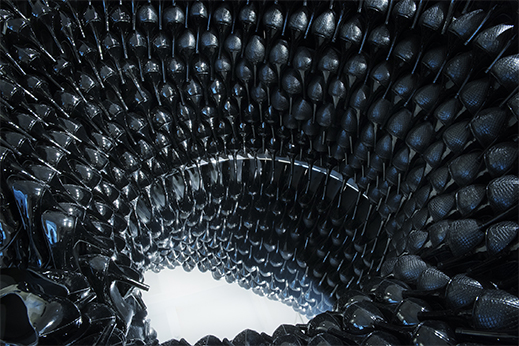 |
|
jogi, 2017, 165 pairs of black high-heeled shoes |
That is not to say that her concerns about the status of women in society are any less explicit in such works. The abstract shoe sculpture, one of the highlights of this exhibition, is titled jogi, which might be translated "woman's propriety." A circular array of intricately layered black high-heels -- 165 pairs in all -- surrounds a mirror, flush with the floor, that reflects the white ceiling high above. In a long essay about the work on her website (unfortunately only in Japanese; the following is my translation), the artist speaks of heels as an emblem of the pain and sacrifice women must endure to make their way in the workplace and society at large, addressing particularly the dilemmas faced by contemporary Japanese women in their thirties like herself:
"In love, housework, birth, child-rearing -- the experiences deemed most essentially female -- women are expected to behave 'properly.' Women in their thirties today must deal with those expectations while trying to realize their own individual dreams. Thus every step they take is the product of a firm resolve. The accumulation of those resolute steps as they advance is what makes women strong and beautiful." She goes on to explain the shape of the work as evoking a collar around the neck, with the mirror representing the scrutiny of society. She has bound the layers of shoes together horizontally but not vertically, she adds, to reflect the importance of lateral relationships in women's lives.
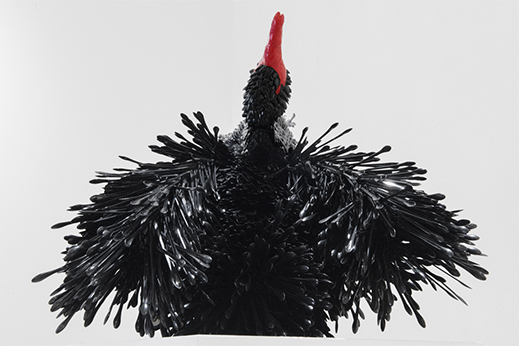 |
|
push beyond one's limit, 2016, black plastic swizzle sticks, rubber, steel, rubber-coated wire, glue, lacquer paint |
One of the few figurative pieces here is push beyond one's limit, a sculpture of a black swan built entirely of black plastic swizzle sticks. In her essay, Tsuchida alludes to the "black swan" metaphor for the occurrence of unanticipated events, often of great consequence, that had been dismissed as inconceivable. It is precisely such events that we need to be strong enough to embrace, she says. The swan's blackness signifies the absorption of all things, while the red of its beak -- the portal through which all is ingested -- is the color of blood. Tsuchida writes that she aspires to be like the swan: a creature capable of taking in joy and sorrow, pain and pleasure alike. Artists especially, she declares, must remain open to the unexpected and avoid shutting themselves behind the wall of "common sense."
The city of Hiratsuka sits on the Shonan Coast a few miles west of Kamakura and only an hour by train from Tokyo. It is worth a visit not only to see the Tsuchida exhibition, but to enjoy the ambience of its Museum of Art, a spacious, sunlit structure whose high arched ceilings emulate those of Paris's celebrated Musee d'Orsay. The atrium-like space provides an ideal environment for viewing Tsuchida's works at leisure.
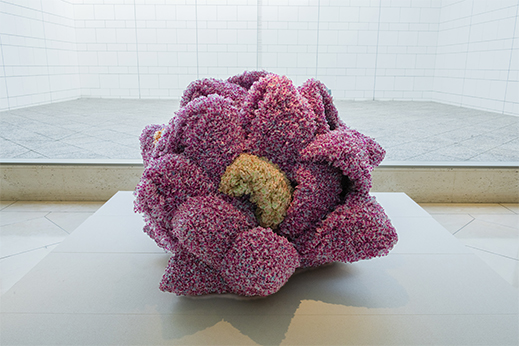 |
|
mammamia, 2018, "Milky" candy paper wrappers, rubber coating |
All images © Hiroko Tsuchida, courtesy of the Hiratsuka Museum of Art. |
|
|
| |
 |
Alan Gleason
Alan Gleason is a translator, editor and writer based in Tokyo, where he has lived for over 30 years. In addition to writing about the Japanese art scene he has edited and translated works on Japanese theater (from kabuki to the avant-garde) and music (both traditional and contemporary). |
|
|
|
|
|
|
|
|
|
 |
|